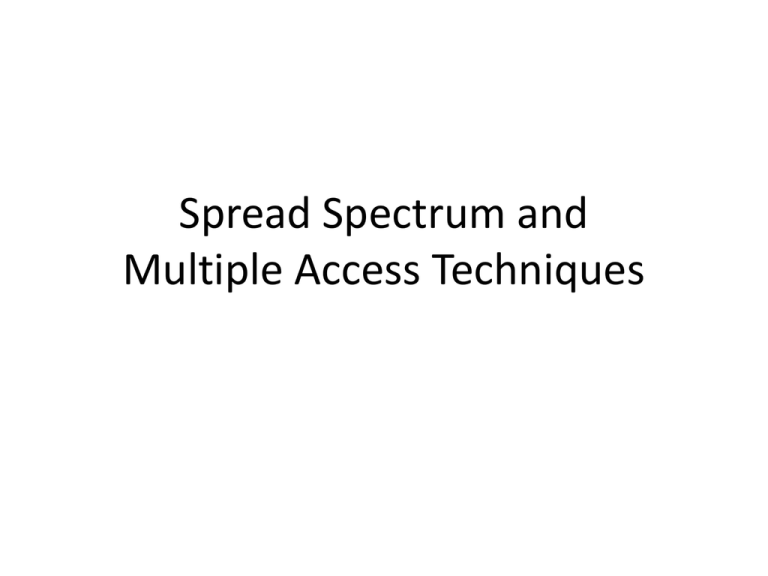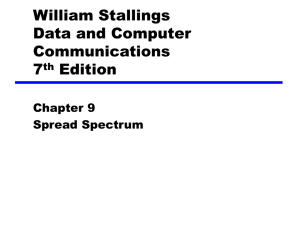Spread Spectrum and Multiple Access Techniques
advertisement

Spread Spectrum and Multiple Access Techniques Spread Spectrum • • • • • Analog or digital data Analog signal Spread data over wide bandwidth Makes jamming and interception harder Frequency hoping – Signal broadcast over seemingly random series of frequencies • Direct Sequence – Each bit is represented by multiple bits in transmitted signal – Chipping code Spread Spectrum Concept • Input fed into channel encoder – Produces narrow bandwidth analog signal around central frequency • Signal modulated using sequence of digits – Spreading code/sequence – Typically generated by pseudonoise/pseudorandom number generator • Increases bandwidth significantly – Spreads spectrum • Receiver uses same sequence to demodulate signal • Demodulated signal fed into channel decoder General Model of Spread Spectrum System Pseudorandom Numbers • Generated by algorithm using initial seed • Deterministic algorithm – Not actually random – If algorithm good, results pass reasonable tests of randomness • Need to know algorithm and seed to predict sequence Frequency Hopping Spread Spectrum (FHSS) • Signal broadcast over seemingly random series of frequencies • Receiver hops between frequencies in sync with transmitter • Eavesdroppers hear unintelligible blips • Jamming on one frequency affects only a few bits Basic Operation • Typically 2k carriers frequencies forming 2k channels • Channel spacing corresponds with bandwidth of input • Each channel used for fixed interval – 300 ms in IEEE 802.11 – Some number of bits transmitted using some encoding scheme • May be fractions of bit (see later) – Sequence dictated by spreading code Frequency Hopping Example Frequency Hopping Spread Spectrum System (Transmitter) Frequency Hopping Spread Spectrum System (Receiver) Slow and Fast FHSS • • • • • Frequency shifted every Tc seconds Duration of signal element is Ts seconds Slow FHSS has Tc Ts Fast FHSS has Tc < Ts Generally fast FHSS gives improved performance in noise (or jamming) Direct Sequence Spread Spectrum (DSSS) • Each bit represented by multiple bits using spreading code • Spreading code spreads signal across wider frequency band – In proportion to number of bits used – 10 bit spreading code spreads signal across 10 times bandwidth of 1 bit code • One method: – – – – Combine input with spreading code using XOR Input bit 1 inverts spreading code bit Input zero bit doesn’t alter spreading code bit Data rate equal to original spreading code • Performance similar to FHSS Direct Sequence Spread Spectrum Transmitter Direct Sequence Spread Spectrum Transmitter Multiple Access Techniques • The transmission from the BS in the downlink can be heard by each and every mobile user in the cell, and is referred as broadcasting. Transmission from the mobile users in the uplink to the BS is many-to-one, and is referred to as multiple access. • Multiple access schemes to allow many users to share simultaneously a finite amount of radio spectrum resources. – Should not result in severe degradation in the performance of the system as compared to a single user scenario. – Approaches can be broadly grouped into two categories: narrowband and wideband. Multiple Access Techniques • Multiple Accessing Techniques : with possible conflict and conflict- free – Random access – Frequency division multiple access (FDMA) – Time division multiple access (TDMA) – Spread spectrum multiple access (SSMA) : an example is Code division multiple access (CDMA) – Space division multiple access (SDMA) Duplexing • For voice or data communications, must assure two way communication (duplexing, it is possible to talk and listen simultaneously). Duplexing may be done using frequency or time domain techniques. – Forward (downlink) band provides traffic from the BS to the mobile – Reverse (uplink) band provides traffic from the mobile to the BS. Frequency division duplexing (FDD) • Provides two distinct bands of frequencies for every user, one for downlink and one for uplink. • A large interval between these frequency bands must be allowed so that interference is Forward minimized. Reverse Channel Channel fc, fc,, R F frequency Frequency separation Frequency separation should be carefully decided Frequency separation is constant Time division duplexing (TDD) • In TDD communications, both directions of transmission use one contiguous frequency allocation, but two separate time slots to provide both a forward and reverse link. • Because transmission from mobile to BS and from BS to mobile alternates in time, this scheme is also known as “ping pong”. • As a consequence of the use of the same frequency band, the communication quality in both directions is the same. This is different from FDD. FDMA • In FDMA, each user is allocated a unique frequency band or channel. During the period of the call, no other user can share the same frequency band. FDMA • All channels in a cell are available to all the mobiles. Channel assignment is carried out on a first-come first- served basis. • The number of channels, given a frequency spectrum BT , depends on the modulation technique (hence Bw or Bc ) and the guard bands between the channels 2Bguard . These guard bands allow for imperfect filters and oscillators and can be used to minimize adjacent channel interference. • FDMA is usually implemented in narrowband systems. Main features • Continuous transmission : the channels, once assigned, are used on a non-time-sharing basis. This means that both subscriber and BS can use their corresponding allotted channels continuously and simultaneously. • Narrow bandwidth : Analog cellular systems use 25-30 kHz. Digital FDMA systems can make use of low bit rate speech coding techniques to reduce the channel band even more. • If FDMA channels are not in use, then they sit idle and cannot be used by other users to increase capacity. • Low ISI : Symbol time is large compared to delay spread. No equalizer is required (Delay spread is generally less than a few μs – flat fading). Main features • Low overhead : Carry overhead messages for control, synchronization purposes. As the allotted channels can be used continuously, fewer bits need to be dedicated compared to TDMA channels. • Simple hardware at mobile unit and BS : (1) no digital processing needed to combat ISI (2) ease of framing and synchronization. • Use of duplexer since both the transmitter and receiver operate at the same time. This results in an increase in the cost of mobile and BSs. • FDMA required tight RF filtering to minimize adjacent channel interference. TDMA • TDMA systems divide the channel time into frames. Each frame is further partitioned into time slots. In each slot only one user is allowed to either transmit or receive. • Unlike FDMA, only digital data and digital modulation must be used. • Each user occupies a cyclically repeating time slot, so a channel may be thought of as a particular time slot of every frame, where N time slots comprise a frame. Features • Multiple channels per carrier or RF channels. • Burst transmission since channels are used on a timesharing basis. Transmitter can be turned off during idle periods. • Narrow or wide bandwidth – depends on factors such as modulation scheme, number of voice channels per carrier channel. • High ISI – Higher transmission symbol rate, hence resulting in high ISI. Adaptive equalizer required. Features • High framing overhead – A reasonable amount of the total transmitted bits must be dedicated to synchronization purposes, channel identification. Also guard slots are necessary to separate users. TDMA Frame One TDMA Frame Preamble Guard Bits Information Slot 1 Slot 2 Sync Bits Control Bits Trail Bits Slot 3 … Information One TDMA Slot A Frame repeats in time Slot N CRC Code Division Multiple Access (CDMA) • In CDMA, the narrowband message signal is multiplied by a very large bandwidth signal called spreading signal (code) before modulation and transmission over the air. This is called spreading. • CDMA is also called DSSS (Direct Sequence Spread Spectrum). DSSS is a more general term. • Message consists of symbols – Has symbol period and hence, symbol rate EE 552/452 Spring 2007 Code Division Multiple Access (CDMA) • Spreading signal (code) consists of chips – Has Chip period and and hence, chip rate – Spreading signal use a pseudo-noise (PN) sequence (a pseudorandom sequence) – PN sequence is called a codeword – Each user has its own cordword – Codewords are orthogonal. (low autocorrelation) – Chip rate is oder of magnitude larger than the symbol rate. • The receiver correlator distinguishes the senders signal by examining the wideband signal with the same timesynchronized spreading code • The sent signal is recovered by despreading process at the receiver. CDMA Advantages • Low power spectral density. – Signal is spread over a larger frequency band – Other systems suffer less from the transmitter • Interference limited operation – All frequency spectrum is used • Privacy – The codeword is known only between the sender and receiver. Hence other users can not decode the messages that are in transit • Reduction of multipath affects by using a larger spectrum CDMA Advantages • Random access possible – Users can start their transmission at any time • Cell capacity is not concerete fixed like in TDMA or FDMA systems. Has soft capacity • Higher capacity than TDMA and FDMA • No frequency management • No equalizers needed • No guard time needed • Enables soft handoff



